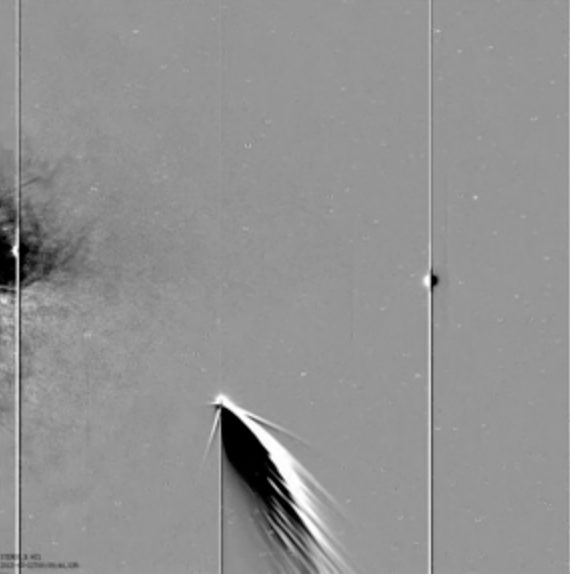NASA Spacecraft Sees Comet, Earth and Mercury Together (Video)

A new video from a NASA spacecraft studying the sun has captured an unexpected sight: a wandering comet posing with the planets Earth and Mercury.
The cosmic view comes from one of NASA's twin Stereo spacecraft that constantly watch the sun for signs of solar flares and other space weather events. It shows Mercury and Earth as they appeared with the Comet Pan-STARRS, a comet that is currently visible from the Northern Hemisphere during evening twilight.
The probe captured the video of Comet Pan-STARRS, Earth and Mercury together while observing the sun from March 9 to March 12.
According to a NASA description, the video "shows the comet and its fluttering tail as it moves through space." The Earth appears as a bright stationary object on the right side of the video, while Mercury is visible as a moving light on the left side. [How to see Comet Pan-STARRS]
The sun is actually out of the frame in the Stereo-B spacecraft's video, but its solar wind is visible as a stream of material, NASA officials explained. Meanwhile, the view of Comet Pan-STARRS from space is giving scientists a wealth of data to review, they added.
"Comet scientists say the tail looks quite complex and it will take computer models to help understand exactly what’s happening in STEREO’s observations," agency officials said in a video description. "The comet should remain visible to the naked eye through the end of March."
Comet Pan-STARRS is currently visible to stargazers in the Northern Hemisphere just after sunset. To see the comet, look low on the western horizon just after the sun has gone down. Comet Pan-STARRS can appear as a bright head with a wispy trail, weather permitting, though some stargazers have said the bright evening twilight can make spotting it tricky.
Get the Space.com Newsletter
Breaking space news, the latest updates on rocket launches, skywatching events and more!
The Comet Pan-STARRS was discovered in June 2011 by astronomers using the Panoramic Survey Telescope & Rapid Response System (Pan-STARRS) in Hawaii. The comet's official name is C/2011 L4 (PANSTARRS).
Scientists estimate that Comet Pan-STARRS takes about 110,000 years to orbit the sun after this first swing through the inner solar system. The comet crossed into the Northern Hemisphere evening sky last week after months of being visible to observers in the Southern Hemisphere.
NASA's twin Stereo A and B spacecraft (the name is short for Solar TErrestrial RElations Observatory) observe the sun in tandem to provide unparalleled views of how material from solar eruptions makes its way to Earth. The spacecraft launched in 2006 and are part of a fleet of sun-watching spacecraft that monitor solar storms.
Comet Pan-STARRS is one of several comets gracing the night sky in 2013. Pan-STARRS was joined by the Comet Lemmon earlier this year when both were visible together in the Southern Hemisphere sky. Later this year, the sungrazing Comet ISON could put on a potentially dazzling display when it makes its closest approach to the sun in late November.
Editor's note: If you snap an amazing photo of Comet Pan-STARRS in the night sky, or any other celestial object, and you'd like to share for a possible story or image gallery, please send images and comments, including location information, to managing editor Tariq Malik at spacephotos@space.com.
This story was updated to correct the orbit of Comet Pan-STARRS, which is thought to be about 110,000 years after this pass around the sun.
Email Tariq Malik at tmalik@space.com or follow him @tariqjmalik and Google+. Follow us @Spacedotcom, Facebook and Google+. Original article on SPACE.com.
Join our Space Forums to keep talking space on the latest missions, night sky and more! And if you have a news tip, correction or comment, let us know at: community@space.com.

Tariq is the Editor-in-Chief of Space.com and joined the team in 2001, first as an intern and staff writer, and later as an editor. He covers human spaceflight, exploration and space science, as well as skywatching and entertainment. He became Space.com's Managing Editor in 2009 and Editor-in-Chief in 2019. Before joining Space.com, Tariq was a staff reporter for The Los Angeles Times covering education and city beats in La Habra, Fullerton and Huntington Beach. In October 2022, Tariq received the Harry Kolcum Award for excellence in space reporting from the National Space Club Florida Committee. He is also an Eagle Scout (yes, he has the Space Exploration merit badge) and went to Space Camp four times as a kid and a fifth time as an adult. He has journalism degrees from the University of Southern California and New York University. You can find Tariq at Space.com and as the co-host to the This Week In Space podcast with space historian Rod Pyle on the TWiT network. To see his latest project, you can follow Tariq on Twitter @tariqjmalik.









